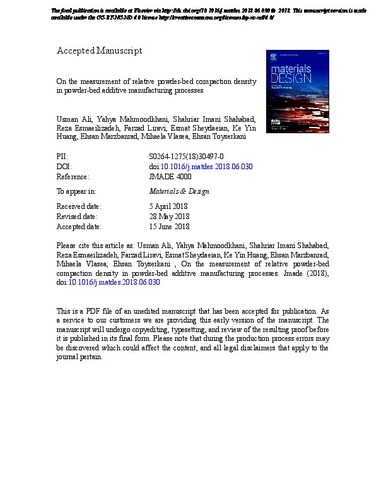| dc.contributor.author | Ali, Usman | |
| dc.contributor.author | Mahmoodkhani, Yahya | |
| dc.contributor.author | Imani Shahabad, Shahriar | |
| dc.contributor.author | Esmaeilizadeh, Reza | |
| dc.contributor.author | Liravi, Farzad | |
| dc.contributor.author | Sheydaeian, Esmat | |
| dc.contributor.author | Huang, Ke Yin | |
| dc.contributor.author | Marzbanrad, Ehsan | |
| dc.contributor.author | Vlasea, Mihaela | |
| dc.contributor.author | Toyserkani, Ehsan | |
| dc.date.accessioned | 2018-06-28 15:34:01 (GMT) | |
| dc.date.available | 2018-06-28 15:34:01 (GMT) | |
| dc.date.issued | 2018-10-05 | |
| dc.identifier.uri | https://doi.org/10.1016/j.matdes.2018.06.030 | |
| dc.identifier.uri | http://hdl.handle.net/10012/13444 | |
| dc.description | The final publication is available at Elsevier via http://dx.doi.org/10.1016/j.matdes.2018.06.030 © 2018. This manuscript version is made available under the CC-BY-NC-ND 4.0 license http://creativecommons.org/licenses/by-nc-nd/4.0/ | en |
| dc.description.abstract | Experimental studies in the literature have identified the powder-bed compaction density as an important parameter, governing the quality of additively manufactured parts. For example, in laser powder-bed fusion (LPBF), the powder-bed compaction density directly affects the effective powder thermal conductivity and consequently the temperature distribution in melt pool. In this study, this physical parameter in a LPBF build compartment is measured using a new methodology. A UV curable polymer is used to bind powder-bed particles at various locations on the powder-bed compartment when Hastelloy X was used. The samples are then scanned using a nano-computing tomography (CT) system at high resolution to obtain an estimation of the relative powder-bed compaction density. It is concluded that due to the interaction between the recoater and the variation in the powder volume accumulated ahead of the recoater across the build compartment, the relative powder-bed compaction density decreases along the recoater moving direction (from 66.4% to 52.4%.). This variation in the powder-bed compaction density affects the density and surface roughness of the final printed parts that is also investigated. Results show that the part density and surface quality decrease ~0.25% and ~20%, respectively, along the build bed in direction of the recoater motion. | en |
| dc.description.sponsorship | Natural Sciences and Engineering Research Council of Canada (NSERC)
Federal Economic Development Agency for Southern Ontario (FedDev Ontario) | en |
| dc.language.iso | en | en |
| dc.publisher | Elsevier | en |
| dc.rights | Attribution-NonCommercial-NoDerivatives 4.0 International | * |
| dc.rights.uri | http://creativecommons.org/licenses/by-nc-nd/4.0/ | * |
| dc.subject | Additive manufacturing | en |
| dc.subject | 3D printing | en |
| dc.subject | Compaction density | en |
| dc.subject | Selective laser melting | en |
| dc.subject | Laser powder-bed fusion | en |
| dc.subject | Hastelloy X | en |
| dc.title | On the measurement of relative powder-bed compaction density in powder-bed additive manufacturing processes | en |
| dc.type | Article | en |
| dcterms.bibliographicCitation | Ali, U., Mahmoodkhani, Y., Imani Shahabad, S., Esmaeilizadeh, R., Liravi, F., Sheydaeian, E., … Toyserkani, E. (2018). On the measurement of relative powder-bed compaction density in powder-bed additive manufacturing processes. Materials & Design, 155, 495–501. https://doi.org/10.1016/j.matdes.2018.06.030 | en |
| uws.contributor.affiliation1 | Faculty of Engineering | en |
| uws.contributor.affiliation2 | Mechanical and Mechatronics Engineering | en |
| uws.typeOfResource | Text | en |
| uws.peerReviewStatus | Reviewed | en |
| uws.scholarLevel | Faculty | en |


